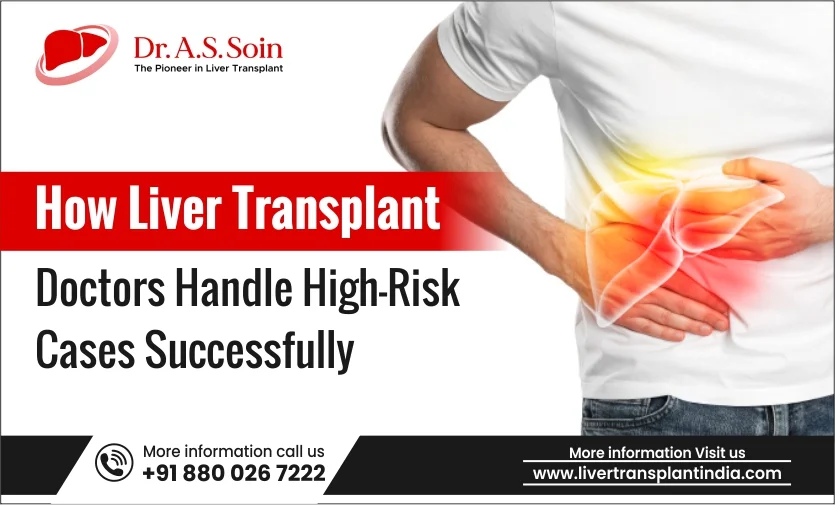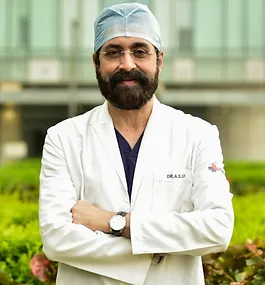When you hear “liver transplant,” it sounds like a single, big operation — remove the diseased liver, put in a new one, and done. But the truth? The toughest cases are never that simple.
Some patients reach the hospital too late — skin yellow, belly swollen, kidneys failing, infections raging. Others have heart problems, obesity, uncontrolled diabetes, or previous abdominal surgeries. A few have even had failed transplants before.
These are what specialists quietly call high-risk liver transplant cases — and handling them is nothing short of an art.
Still, many of these patients do survive. Some even thrive better than average-risk ones.
Why? Because transplant doctors don’t treat these as “hopeless” — they treat them as “complex puzzles that need more thought, more coordination, and more heart.”
Table of Contents
ToggleThe Art Before the Surgery: Choosing Battles Wisely
A liver transplant doctor doesn’t operate the moment a patient arrives. The first, and perhaps the most critical decision, is whether the patient should undergo surgery at all.
In high-risk cases, this is where the expertise really shines.
Doctors assess:
- How sick is the patient? Not just in numbers, but in actual resilience.
- What’s reversible and what’s not? For example, severe kidney failure might improve after liver recovery, but irreversible lung disease may not.
- Are there hidden infections brewing?
- Is there any correctable problem before we go in?
- How strong are the patient’s nutrition and immunity levels?
- Can the body handle the anesthesia, blood loss, and the long hours of surgery?
- What are the odds of survival post-surgery — not just days, but years down the line?
A senior transplant surgeon once said, “Sometimes, the best decision is not doing the surgery — at least, not yet.”
That’s the kind of judgment that separates a good doctor from a great one.
Risk Scoring: The Science of Prediction
High-risk transplants are not judged by gut feeling alone. They are evaluated through risk scoring systems that predict outcomes.
Doctors use measures like:
- MELD score (Model for End-Stage Liver Disease): tells how sick the liver is.
- Cardiac function tests: tell how much stress the body can take.
- Donor Risk Index (DRI): shows how strong or fragile the donor liver is.
But here’s where experience overrides mathematics.
A surgeon may see two patients with the same MELD score — but one has a fighting spirit, better nutrition, and fewer infections. That person’s chances are far better.
So, while algorithms help, human judgment still rules. Numbers can’t read resilience.
The Power of Team Decisions, Not Heroism
People often think of transplant surgery as a one-man show. But no liver transplant happens without a multidisciplinary team — hepatologists, anesthetists, intensivists, radiologists, and coordinators all working as one.
In high-risk situations, this teamwork becomes the real backbone.
Take for instance, a patient with severe heart dysfunction. Before the transplant, a cardiologist and anesthetist jointly evaluate how much stress the heart can take. If they say no, the surgeon waits. If they say maybe, they build a plan around it — adjusting fluids, optimizing oxygen, even scheduling shorter anesthesia exposure.
It’s not about “can we do it?” but rather “how can we make it possible safely?”
That kind of shared decision-making is what saves lives in these edge cases.
Post-Surgery Rehab: The Forgotten Half of Success
Once the operation is done, everyone tends to think “the tough part is over.” Not really.
The real battle often starts after surgery.
High-risk patients usually have weaker immunity, slower wound healing, and more medical dependencies. So, post-transplant rehabilitation is an entire ecosystem in itself.
- Nutritionists rebuild the diet from liquids to full meals, rich in protein but easy on the liver.
- Physiotherapists start early mobilization to prevent muscle loss.
- Psychologists address post-surgery anxiety and “survivor’s guilt.”
- Transplant coordinators ensure every follow-up test and medication is timed correctly.
One small mistake — a missed dose, an unnoticed fever — can undo weeks of success.
That’s why top centers don’t just discharge patients; they “walk them through recovery.”
It’s not just surgery that saves life — discipline after it does too.
The Clock and the Coordination
Timing in liver transplant is everything — and in high-risk cases, it’s the entire game.
Once a donor liver becomes available, the team races against time. But unlike a regular surgery, the team can’t just “go in and start.” For a high-risk patient, the pre-op optimization may take longer than the surgery itself.
- Blood parameters must be balanced.
- Infections must be brought under control.
- Nutrition often needs last-minute correction.
- Coexisting diseases (like diabetes or hypertension) have to be fine-tuned literally till the last minute.
Many successful high-risk transplants are not “miracles” — they’re the result of hundreds of micro-decisions taken correctly in sequence.
When Donor Quality Isn’t Perfect
Not every patient gets an ideal donor liver. Sometimes, only marginal livers — from older donors, fatty livers, or extended criteria donors — are available.
Rejecting these outright could mean a patient dies waiting.
So transplant doctors take a bold yet measured approach:
- They recondition the donor liver using machine perfusion — keeping it warm, oxygenated, and flushed for hours until it improves.
- They biopsy and analyze small samples in real time to judge if it’s usable.
- They tailor the surgery — adjusting blood flow techniques and minimizing stress on the graft.
In short, they turn “not good enough” organs into viable lifesavers.
That’s why some of the most complex, life-saving transplants happen when the donor organ itself wasn’t perfect — but the strategy was.
Inside the Operating Room: Where Skill Meets Instinct
Once the surgery starts, every minute counts. But what’s fascinating is — the best liver transplant surgeons don’t rely purely on robotic precision. They rely on experience-driven intuition.
For example, if bleeding is heavier than expected, they might choose to slow down and reassess instead of rushing. If the blood pressure dips sharply, they might alter the surgical plan midway — reconnect vessels differently, change the sequence of clamping, or switch to a “piggyback technique” to keep circulation going.
It’s this ability to read the body like a live instrument that makes the difference.
Some surgeons say that by the time they finish their 100th transplant, they can “feel” when the graft (new liver) is happy or not — even before the machines confirm it.
That’s experience meeting instinct — science meeting art.
The Post-Op Phase: The Quiet Battle
If the surgery is the storm, the ICU is the calm after it — but not in the relaxing sense.
The post-operative phase is where high-risk patients either stabilize or spiral. Doctors track liver enzymes, oxygenation, coagulation, and signs of infection hourly. Even the smallest sign — say, a mild temperature or subtle drop in urine — can mean something big.
The doctors make quick, adaptive decisions here:
- Adjusting immunosuppressants to avoid rejection while preventing infection.
- Managing fluid balance to avoid overloading a weak heart or kidney.
- Tuning nutrition and electrolytes daily to help the new liver settle in.
Here, a liver transplant specialist’s attention to detail and communication with the ICU team make all the difference.
Many successful high-risk transplants are won after the surgery — during those first 10 critical days.
Technology’s Quiet Role
Technology doesn’t just mean robotic surgery. In liver transplants, it means smarter planning.
- 3D imaging now lets surgeons map liver anatomy down to each vein and bile duct — crucial in living donor cases.
- Machine perfusion systems keep donor livers “alive” outside the body, improving organ quality even for marginal grafts.
- AI-assisted prediction tools help estimate risk scores, survival odds, and even optimal immunosuppressant doses.
But even with all that, every top surgeon will tell you — tech is only as good as the hands and minds using it.
The brilliance lies not in machines but in how doctors interpret and act on what the machines show.
The Human Factor: Why Trust and Mental Strength Matter
When a patient is called “high-risk,” it’s not just the body under stress — the family, too, carries that burden.
Experienced liver transplant doctors don’t just manage the operation. They manage hope.
They talk with families honestly — not sugarcoating, but not hopeless either. They prepare them for possibilities but also guide them on what to expect. That trust between the doctor and family often becomes the emotional glue that holds everything together during uncertain nights.
For many patients, survival begins not on the table but in their belief that their team won’t give up.
What Sets Successful Transplant Centers Apart
You’ll notice — in centers that consistently handle tough cases, a few silent systems always work in the background:
- Transparent communication — doctors and families are on the same page.
- Zero ego in the team — every department has a voice in key decisions.
- Round-the-clock readiness — because donor calls can come anytime, and every hour matters.
- Follow-up obsession — they don’t just operate and forget; they track recovery like a long-term project.
- Patient-specific strategy — not all protocols fit everyone; high-risk patients often get custom immunosuppressant combinations or staggered rehab schedules.
These things can’t be copied overnight. They come from years of disciplined teamwork and culture.
Beyond Surgery: Building a Second Chance at Life
The ultimate measure of success for a high-risk liver transplant isn’t just surviving surgery — it’s returning to life.
Patients who were bed-bound for months start walking again. Those who couldn’t eat now enjoy regular meals. Some even go back to work within a year.
Doctors say that seeing such recoveries keeps them grounded. Each high-risk transplant reminds them that medicine isn’t about playing safe — it’s about finding the safest way to do the impossible. http://library.stamforduniversity.edu.bd/
The Real Secret: Precision, Patience, and Perspective
So how do liver transplant doctors handle high-risk cases successfully?
Not by magic, and not by chance.
They succeed because they prepare deeply, decide wisely, act calmly, and never stop adjusting.
They see beyond the risk — into what’s possible when everything is done right.
It’s not a race. It’s a rhythm — one that takes skill, instinct, and heart.








